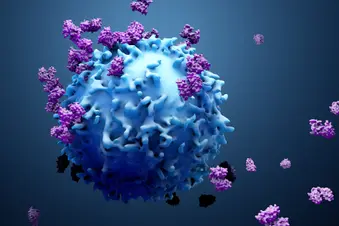
Epidermal growth factor receptor (EGFR) is a protein on the surface of your cells that helps them grow. When the gene that codes for EGFR has a mutation, it affects the way this protein works, causing cancer.
There are many types of EGFR mutations.
What’s an EGFR Mutation?
The EGFR protein lives in the cell membrane with one side facing inside the cell and one side sticking outside the cell. The outer part of EGFR works like a lock, and other proteins are like keys that fit into that lock.
When proteins bind to EGFR, they send certain signals to your cell to help it respond to its environment. Usually, this means it tells your cell to grow and divide.
The EGFR gene is like an instruction manual for making the EGFR protein. Mutations are like typos in these instructions.
Some EGFR mutations are like deleting letters or words to these instructions (called deletions) or adding letters or words (called insertions). Point mutations are like misspelled words where only one letter is deleted, inserted, or changed.
This change in the instructions turns on EGFR’s “grow and divide” signal and keeps it stuck there. This uncontrolled division of cells causes cancer.
EGFR and NSCLC
There are two main types of lung cancer: small-cell and non-small cell lung cancer (NSCLC). Most lung cancer cases are NSCLC.
About 32% of NSCLC cases worldwide involve an EGFR mutation. The most common subtype to have an EGFR mutation is adenocarcinoma.
People at the highest risk of having EGFR-positive lung cancer include:
- People who’ve never smoked or only smoked a little
- People with lung adenocarcinoma
- Women
- Young adults with lung cancer
- People of Asian or East Asian heritage
Your chances of getting lung cancer are also higher if you:
- Smoke
- Are exposed to radon
- Breathe in particle pollution often
- Have a family history of lung cancer
Testing for EGFR Mutations
Your doctor can do comprehensive testing to see if you have the mutation (or other mutations).
To do the testing, they’ll remove tissue from your lung and perform genetic testing on it. This is called a biopsy. In some cases, if you already had a biopsy to diagnose your lung cancer, your doctor can use this tissue to look for mutations without having to do a second biopsy.
When you have NSCLC, a blood test can also be effective for detecting an EGFR mutation.
These tests not only show whether you have an EGFR mutation, but what kind of mutation it is. There are more than 70 types of EGFR mutations.
Doctors group EGFR mutations in NSCLC into four types:
- Classical EGFR mutations, which include the most common types: EGFR 19 deletions and EGFR L858R point mutations
- EGFR exon 20 insertions
- T790M-like mutations
- P-loop αC-helix compression (PACC) mutations
Classical EGFR mutations account for nearly 90% of all EGFR mutations.
How EGFR Affects NSCLC Treatment
Knowing your EGFR status can have a big impact on which treatment your doctors give you.
If your NSCLC is in an early stage and hasn’t spread, you might be able to have surgery to have it completely removed. If not, your doctor may start you on a targeted therapy.
The type of EGFR inhibitor your doctor gives you will depend on their preference, your specific type and stage of cancer, and your treatment goals.
The EGFR status has the most impact on your treatment plan if you have stage IV NSCLC. Most people with this stage of NSCLC take a pill called EGFR-targeted tyrosine kinase inhibitor (TKI). This medicine blocks (or targets) the signal that tells EGFR to grow.
Some of the FDA-approved TKIs for stage IV EGFR-positive NSCLC include:
- Afatinib (Gilotrif)
- Dacomitinib (Vizimpro)
- Erlotinib (Tarceva)
- Gefitinib (Iressa)
A fifth TKI is approved for stages I-IV:
- Osimertinib (Tagrisso)
Classical EGFR mutations such as EGFR 19 deletions and EGFR L858R point mutations tend to respond best to TKIs.
Rarer types of mutations, such as the EGFR exon 20 insertions, don't respond as well to this therapy. Instead, your doctor may try a targeted treatment. There is one approved EGFR MET-specific antibody:
- Amivantamab (Rybrevant)
Chemotherapy or immunotherapy are other options for treating this type of mutation.
Another treatment your doctor may try for your EGFR-positive NSCLC is ramucirumab (Cyramza) with erlotinib (Tarceva). You get ramucirumab through an IV, and you take erlotinib by mouth. They help control your cancer by blocking proteins needed by your cancer cells to form the blood vessels that help support their growth and spread.
EGFR inhibitors can often control your cancer for several months or even years, but they aren't a cure.
The cancer often adapts to these treatments and may stop responding over time. This is called acquired resistance.
Once this happens, your doctor may do another tissue or blood test. This can tell them if you have any new mutations that can help guide the next steps of your treatment.
Show Sources
Photo Credit: Design Cells / Getty Images
SOURCES:
American Lung Association: “EGFR and Lung Cancer,” “Lung Cancer Causes & Risk Factors.”
MedlinePlus: “EGFR gene.”
American Cancer Society: “What Is Lung Cancer?”
Oncology: “A Patient With Newly Diagnosed, Advanced EGFR-Mutated Non–Small Cell Lung Cancer.”
Lung Cancer Foundation of America: “What is EGFR-positive lung cancer and how is it treated?”
MD Anderson Cancer Center: “Classifying EGFR mutations by structure and function offers better way to match non-small cell lung cancer patients to treatments.”
The Journal of Molecular Diagnostics: “EGFR Mutations in Lung Adenocarcinomas.”
Japanese Journal of Clinical Oncology: “Current treatment strategies for EGFR-mutated non-small cell lung cancer: from first line to beyond osimertinib resistance.”
Biomedicines: “Amivantamab-Vmjw: A Novel Treatment for Patients with NSCLC Harboring EGFR Exon 20 Insertion Mutation after Progression on Platinum-Based Chemotherapy.”